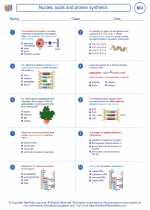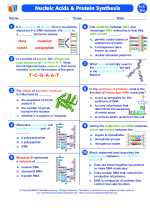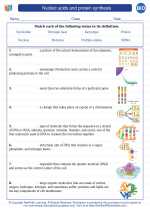Nucleic Acids
Nucleic acids are the macromolecules that store and transmit genetic information in living organisms. There are two main types of nucleic acids: deoxyribonucleic acid (DNA) and ribonucleic acid (RNA).
Structure of Nucleic Acids
DNA and RNA are made up of smaller units called nucleotides. Each nucleotide consists of three components: a phosphate group, a five-carbon sugar (deoxyribose in DNA and ribose in RNA), and a nitrogenous base. The nitrogenous bases in DNA are adenine (A), thymine (T), cytosine (C), and guanine (G), while in RNA, thymine is replaced by uracil (U).
The nucleotides are linked together by phosphodiester bonds between the phosphate group of one nucleotide and the sugar of the next nucleotide, forming a long chain.
Functions of Nucleic Acids
1. Genetic Information Storage: DNA contains the genetic instructions that determine the characteristics of an organism. It is responsible for storing genetic information and passing it on from one generation to the next.
2. Protein Synthesis: RNA plays a key role in protein synthesis. There are different types of RNA, including messenger RNA (mRNA), transfer RNA (tRNA), and ribosomal RNA (rRNA), each involved in different stages of protein synthesis.
Study Guide
To study nucleic acids effectively, consider the following key points:
- Understand the structure of a nucleotide, including the components and the different nitrogenous bases found in DNA and RNA.
- Learn the process of DNA replication, transcription, and translation, and understand the roles of DNA and RNA in these processes.
- Understand the concept of genetic information storage and the central dogma of molecular biology.
- Explore genetic disorders and mutations related to nucleic acids, and their impact on protein synthesis and organismal characteristics.
- Review the functions of different types of RNA and their roles in protein synthesis.
By mastering these key points, you'll have a solid understanding of nucleic acids and their crucial roles in living organisms.
.◂Biology Worksheets and Study Guides High School. Nucleic acids and protein synthesis

 Worksheet/Answer key
Worksheet/Answer key
 Worksheet/Answer key
Worksheet/Answer key
 Worksheet/Answer key
Worksheet/Answer key
 Vocabulary/Answer key
Vocabulary/Answer key
 Vocabulary/Answer key
Vocabulary/Answer key
 Vocabulary/Answer key
Vocabulary/Answer key
